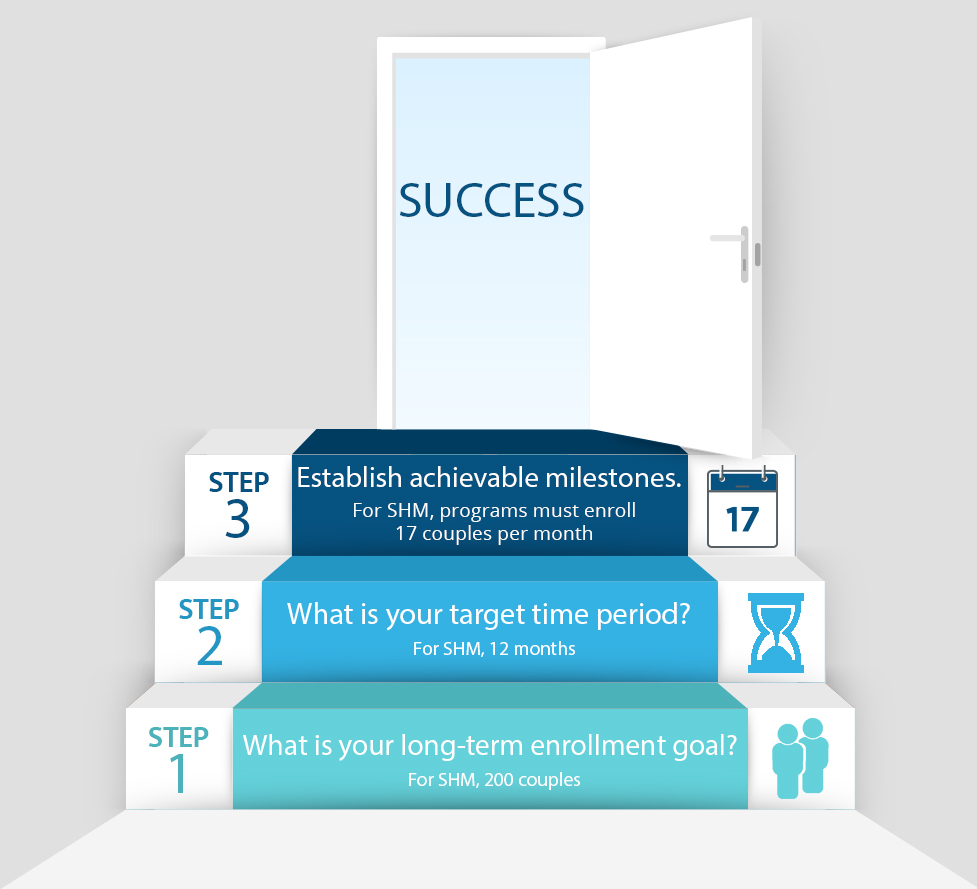Steps to Achievable Benchmarks: A Look at Enrollment Targets

In an earlier post, Setting Strong Benchmarks, we explored key questions for program administrators as they measure progress toward their goals. In this post, we look at the nuts and bolts of establishing the enrollment benchmarks that help programs reach their intended population.
Our partnerships in the Supporting Healthy Marriage (SHM) project illustrate how a simple calculation can break down broad enrollment targets into discrete and manageable goals that reflect a program’s specific needs.
The SHM project involved a large-scale, rigorous test of relationship education programs for low-income, married couples. SHM offerings include workshops, family activities, and support services designed to strengthen family relationships.
For SHM, the first step toward meeting enrollment benchmarks was to define “enrolled.” Since SHM interventions were designed for married couples with children, enrollment meant that both spouses had to attend the intake appointment, agree to participate in the program, and fill out and sign the necessary paperwork. Once these steps were completed, the couple could begin participating in services.
SHM began with enrollment targets of 200 married couples every 12 months for all its programs. But how can a program craft an action plan to accomplish this goal? Dividing the total enrollment goal by units of time is a basic calculation that can help programs chart a path to success.
Armed with a calendar and a calculator, MDRC and SHM staff members got to work by establishing weekly and monthly goals in accordance with a few key steps, illustrated below and then discussed in further detail.

For many programs, including SHM, there are many factors that follow, that can influence the breakdown of an enrollment benchmark:
Fluctuations in a program calendar. Some programs have a hard time enrolling new participants during certain times of the year. For example, SHM programs found that July, August, and December were particularly slow enrollment periods because parents were focused on family activities and holidays. So, program managers built in several down periods that recalibrated their active enrollment period to 9 months instead of 12.

Number of staff members assigned to recruitment and enrollment tasks. It is important to assign responsibility for specific enrollment goals to staff members regardless of whether programs have dedicated personnel for enrollment tasks. To do this, programs can divide their monthly enrollment goals by the number of available staff members.

Variations in service delivery and enrollment. If enrollment is open-ended and a program provides services on an individual basis — for example, through one-on-one meetings or home visits with a practitioner — it may not matter if enrollments are clustered or spread out over a given period.

In the case of closed enrollment, services might begin on a specific day of the month. For instance, if a program delivers its services in group settings, such as classes or workshops with a minimum or a maximum number of participants, enrollments must be grouped together to ensure that there are enough people to begin a new cohort by a specific start date. For SHM, services were delivered through workshops, with an average of 10 couples per session. Recruitment staff members worked in close collaboration with each other to meet the benchmark of enrolling 10 couples in a short period of time, concentrating efforts during certain weeks or around specific recruitment opportunities, such as health fairs or school events.

Additional tips for setting effective enrollment benchmarks:
- Be inclusive. The full program staff should understand enrollment measures, and how their work contributes to achieving enrollment goals.
- Collect and analyze data. Create a report that makes sense of program information so staff members can use it to assess progress toward enrollment goals.
- Take stock. Review data regularly with staff members to reflect on what is—and is not--working. Use these conversations to improve current strategies.







